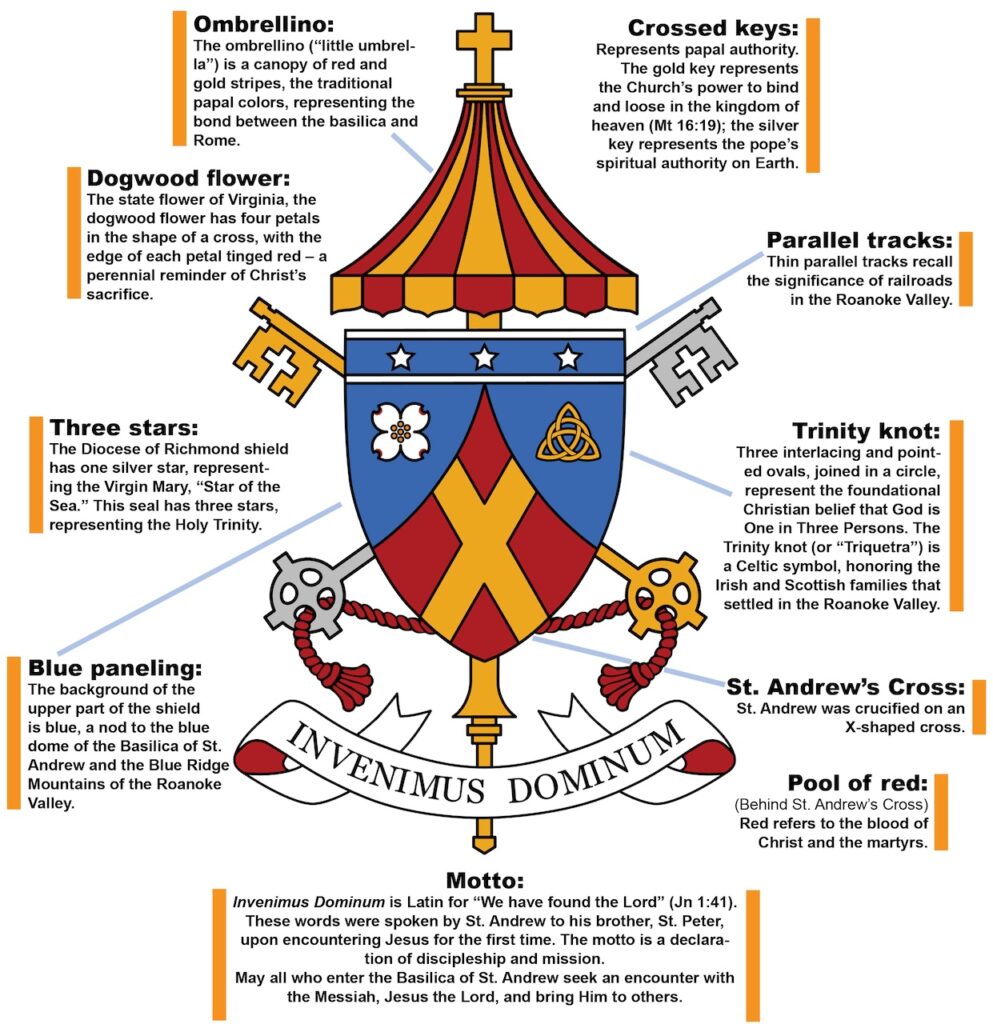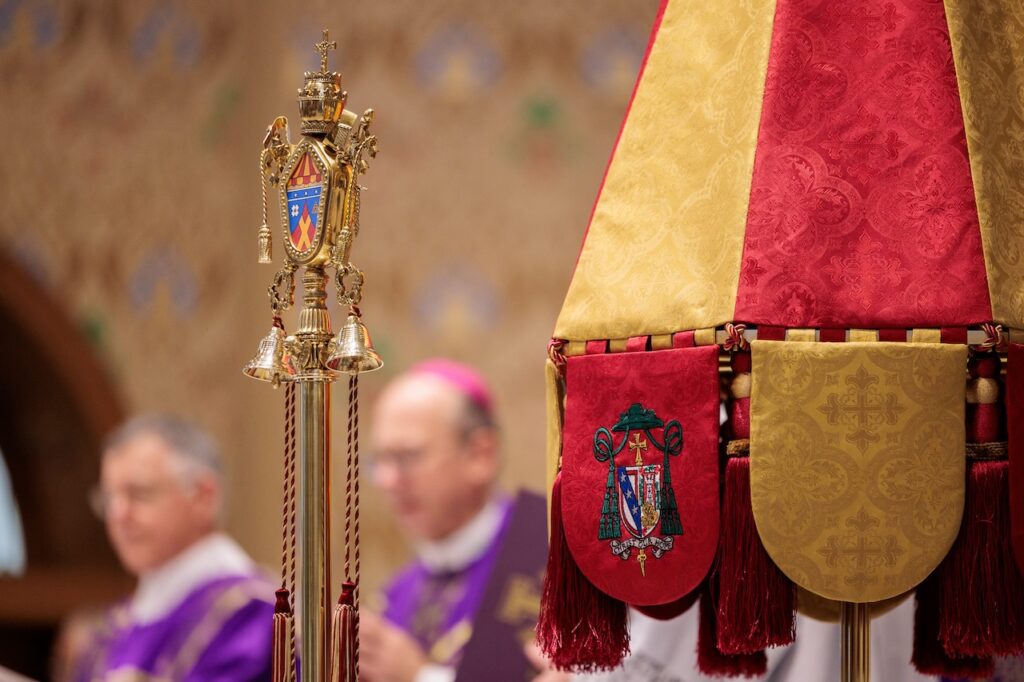Msgr. Thomas Miller says when he first saw the yellow brick church on a hill overlooking the city of Roanoke, he hoped he would serve there. His prayer was answered. For 13 years, he was pastor of the parish with its historic American Gothic church named for St. Andrew.
“It’s not often that a building is this iconic in a community that was not exactly thriving with Roman Catholics, that in the early part of the 20th century they had the foresight to find this place and to raise this building, with modest means and fairly small numbers,” he said. “This is a great story.”
Almost 123 years to the day after the laying of the cornerstone of St. Andrew, worshippers celebrated another milestone in the church’s story: its elevation to the rank of minor basilica.
More than 500 people packed the pews on the first Sunday of Advent Dec. 3 for the blessing of the basilica insignia at a Mass concelebrated by Bishop Barry C. Knestout, basilica rector Father Kevin Segerblom and several priests. Deacons, seminarians and members of the Knights of Columbus also served at Mass.
The stone the original builders accepted in 1900 became the foundation of an “important church, which, while intensifying the bond with the Church of Rome and with the Holy Father, also promotes it as an exemplar of liturgical and pastoral action,” according to the letter accompanying the Vatican decree in September.
“The beautiful liturgies, the richness of its art, the unique history of this sacred space all speak to the worthiness of its designation,” the bishop noted after the reading of the decree.
Links to the Holy See
The symbols of the church’s new status are the ombrellino, a canopy about the size of a furled patio umbrella with a scalloped edge and fabric panels in red and gold, traditional papal colors. In front of it was a tintinnabulum, a set of bells on a pole, with crossed keys projecting from the new basilica seal.
That crest features emblems of the church’s location and history: a blue background for the color of the apse ceiling and the Blue Ridge Mountains; a dogwood flower, for the state of Virginia; two thin, horizontal lines representing railroad tracks; the St. Andrew Cross; a Trinity Knot, for one of the foundational doctrines of the faith; and three silver stars, also representing the Trinity. The motto on the seal is Invenimus Dominum – Latin for “We have found the Lord.”

“May these symbols of our closeness to the See of Peter remind us always of our membership in the pilgrim Church of Christ,” the bishop said in his blessing.
Made in Virginia
Dixon Studio in Staunton managed the production of the insignia. Owners Ron and Annie Dixon had done work for Father Segerblom and for the two other basilicas in Virginia. This was the first time the studio had been asked to make an ombrellino and tintinnabulum and are “probably the only ones ever to be made in Virginia,” Annie said.
They had just two months to fashion these emblems through a combination of custom work and stock items. Both items had to incorporate the new seal. A parish committee came up with ideas for the symbols to use. Ron Dixon did the initial sketches. The rector’s twin brother, Scott, a graphic artist, did computer renderings. “We’re very appreciative of the opportunity to work on such a rare and important commission,” Annie said.

Bishop Knestout and Father Segerblom had hoped that St. Andrew could have been named a basilica in time for the bicentennial of the diocese in 2020, but the pandemic postponed that plan. The initiative resumed two years ago, and the completed application was submitted to the Vatican in June. Father Segerblom thanked the bishop for his review of it, and said he believed that helped win Vatican approval faster than anyone thought possible.
In the end, as the bishop noted, the way the process worked out allowed the church to replace the slate roof, repair the brickwork, and renovate the interior before this historic day, making the church sparkle.
“St. Andrew Basilica is a beacon of prayer and faith in the Roanoke valley, within this Western Vicariate of our Diocese of Richmond,” the bishop said in his homily. “I consider it one of the jewels of the crown of the diocese.
“[At] St. Andrew, [Basilica of St. Mary of the Immaculate Conception] in Norfolk and of course the cathedral in the central part of the diocese … we can come and see where Jesus lives, hear his words, and find the answers to our deepest spiritual longings and needs as we encounter the Lord.”
The bishop said this basilica and all the churches in the diocese are places to experience the love of God in community. “The beauty and dignity of this space, the goodness and solemnity of our celebrations, the truth and power of the words and songs proclaimed here, are effective signs of the spiritual transformation that God brings about within our hearts, within our lives,” he continued.
‘We deeply love this parish’
The day had started out cool and foggy. But during the reading of the Gospel, the sun had broken through. After the ceremonies, people took turns examining the insignia and posing for pictures in front of them. Among those celebrating the occasion was Cathy Connell.
“We’ve been attending here for 21 years and deeply, deeply love this parish,” she said. “And to see it being celebrated in this way and elevated as a place for pilgrimage, as a place where people can come and pray and feel closer to God is wonderful.”
Laurie Hart was baptized and married at St. Andrew. “Every meaningful thing in my life has circled through here,” she said. “This is a proper reflection of what it is in the community and what it is for those that have been here. We’re already seeing more people come in and just taking a look and maybe staying for Mass. We hope they come back.”
In 1907, at the Mass celebrating the silver anniversary of the parish of St. Andrew, Father P.J. Donohoe of the Diocese of Wheeling, West Virginia, noted the beauty of the church in his homily, according to the account in the Roanoke Times.
“How lovely the lines, how stately the spires, how glorious the sunshine filtering in through the many storied windows,” he said. “But – what mean these stones? What is the significance of this structure? What does it mean to us?” The presence of God, and of people living their faith, were the bishop’s answers.
Decades later, the lines are still lovely, the spires just as stately and the meaning of this sacred space of stone and clay, glass and wood is just as solid.
“A building is just a building without a strong community of faith,” Father Segerblom said. “So, I pray that God may continue to bless us to use this basilica and its community to bring people to Christ, just as the bishop said in his homily, and just as St. Andrew did for God’s greater glory.”
Basilica Prayer
Glorious Saint Andrew,
our patron and intercessor before God,
we thank you for having carried our petition to be named a Minor Basilica.
With this designation, may our parish always follow your great example
of love for the Lord Jesus,
of readiness to share his Gospel with others,
and of willingness to embrace his Cross
as the path to life.
Pray for us and for all who may visit this Basilica in the years ahead.
Through Christ our Lord.
Amen.
See more photos from the Dec. 3, 2023 Mass.

